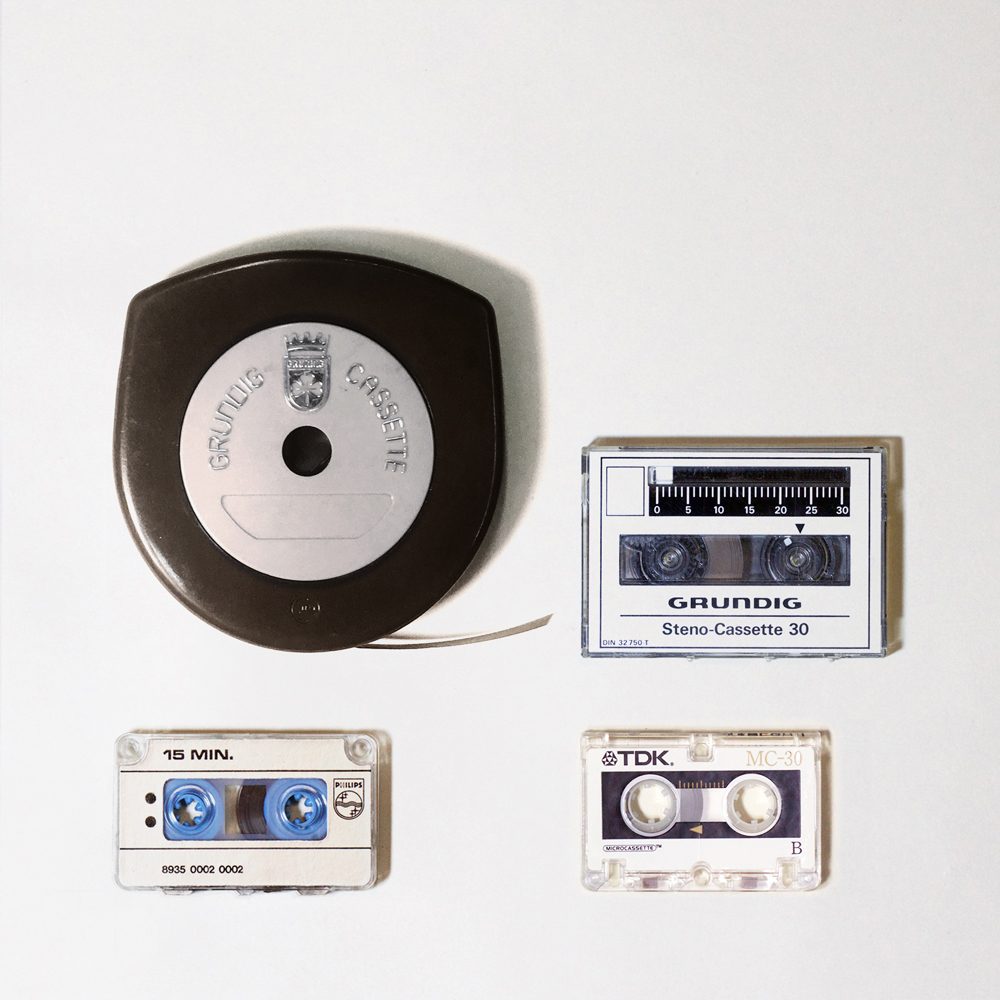introduction to dictation cassette audio tape transfer
At Greatbear, we carefully restore and digitise all three types of small analogue cassette tape: the microcassette, Philips minicassette and Grundig Steno-Cassette.
Recognising that these formats and their players and recorders did not achieve very high quality, we offer two options and methods of transferring microcassettes, minicassettes and steno-cassettes
- transfer using an original microcassette, minicassette or steno-cassette machine
- transfer by respooling the tape into a larger compact cassette shell
We also transfer recordings from the older Grundig Stenorette 543 tapes. Respooling to an open reel is advisable.
We offer a range of delivery formats for our audio transfers. Following International Association of Sound and Audiovisual Archives TC-04 guidelines, we deliver 24-bit / 96 kHz high resolution Broadcast WAV files, together with MP3 audio file or audio CD listening versions. We're happy to create any other digital audio files, according to your needs. We can also digitise to 24-bit / 192 kHz, if required.
We can provide the appropriately-sized USB delivery media for your files, or use media supplied by you, or deliver your files online. Files delivered on hard drive can be for any operating system - MacOS, Windows or GNU/Linux and filesystems (HFS+, NTFS or EXT3).
Given the variety of dictation cassette types / transfer options, and variance in the extent of physical tape degradation, we always assess tapes before confirming the price of a transfer.
We offer free assessments - please contact us to discuss your project.
For an introduction to our assessment and treatment processes, please see our guide to "what happens to your audio tape".
dictation cassette format variation
There are three main types of small analogue recording tape: the Olympus Microcassette; Philips Mini-Cassette (aka minicassette) and the Grundig Steno-Cassette. These were commonly used for voice recordings and portable recording. Due to their inherent low recording quality they don’t have a wide frequency response, making them acceptable for voice recordings but rarely used for music (unless a lo-fi tape sound is specifically desired).
Microcassettes (5 x 3.5 cm) and minicassettes (5.5 x 3.5 cm) look similar but are not compatible, with minicassettes being slightly larger. Microcassettes are capstan-driven; minicassettes are not. This makes minicassette recordings more prone to wow and flutter, but also a more robust system allowing multiple stops, starts, rewinds, fast forwards. Grundig Steno-Cassettes are different again, and can be indentified by their larger size (6.5 x 4.3 cm) and integrated tape counter index.
Common brands of microcassette included Olympus, Sony, Panasonic, Sanyo and TDK. Sanyo also produced minicassettes for dictation and transcription markets, and Philips continue to do so.
Less frequently seen are the earlier Grundig Stenorette 1/4" tapes (top left in image above). It is advisable to wind the 1/4" tape to an open reel before transfer.
dictation cassette variations we work from
| tape manufacturer | dictation tape type | tape speed centimetres per second (cm/s) | track format | supported |
|---|---|---|---|---|
| Olympus / TDK | Microcassette | 2.4 | mono - dual sided | ✓ |
| Olympus / TDK | Microcassette | 1.2 | mono - dual sided | ✓ |
| Olympus / TDK | Stereo Microcassette | 2.4 | stereo - one sided | ✗ |
| Philips | Minicassette | approx. 2.4 | mono - dual sided | ✓ |
| Philips | Minicassette | approx. 2.4 | mono - dual sided | ✓ |
| Grundig | Steno-Cassette | approx 2.4 | mono - one sided | ✓ |
| Grundig | Stenorette 543 | mono - one sided open reel | ✓ |
Scroll to the right to view full table on smaller screens.
dictation cassette tape risks & vulnerabilities
The tape in microcassettes can often snap, pull out from the end of one spool hub or become wrapped around a part of a player’s transport or ‘chewed’. We can repair these problems usually keeping the original shell and minimise any loss of the original recording.
Due to the technical limitations of the microcassette format and its portable design, recording quality may not be very high. These tapes are often good candidates for digital restoration. Using a selection of software tools in particular iZotope RX and Sonnox Restore, our many years' experience and a good acoustic environment, we are able to improve the audibility of speech and reduce a wide range of noise types such as hiss, hums and buzzes that can destroy audibility and reduce listening pleasure.
dictation cassette tape brands / models
- Grundig
- MC45; MC60
- Steno-Cassette 30
- Maxell
- MC60UD
- MC60UR
- Philips
- LFH 0002; LFH 0005
- 0005 Executive
- Olympus
- LM30; LM60
- XB30; XB60
- Sanyo
- mini cassette C-40N
- TDK
- MC30; MC60; MC90
dictation cassette recording history
The microcassette format was developed by introduced in 1969 by Olympus. The tape width is the same as compact cassette, but its shell is much smaller. By using thinner tape and slower recording speeds, recording time was comparable to compact cassette with the MC90 tape offering 45 minutes per side at 2.4 cm/s or 90 minutes per side at 1.2 cm/s. Due to the small tape size, flexible speeds and portable recorders, the microcassette format was popular as a recording medium for dictation and in answering machines.
The Philips minicassette (1967) has a very slightly bigger format cassette shell. It has been used mostly in professional dictation machines, as its capstan-free design makes the transport simple, robust and suitable for repeated and quick forward and reverse winding. Playback speed is easy to alter for transcribing purposes but speed stability and wow and flutter are poor, making it suitable only for voice recording.
